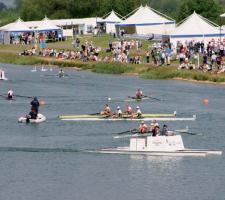
One former UK quarry will be taking centre stage during the 2012 London Olympics in the form of the world-class rowing facilities at Dorney Lake. ABE looks back at how the project came about
Most quarry restoration projects are designed to ameliorate the impact of aggregate production but one UK quarry was borne out of the need for the restoration project. The site in question is Eton Aggregates' Dorney Lake which will be taking centre stage in London's Olympics in 2012 when it hosts the rowing events.
The 2200m rowing course with warm-up channel, finish tower and boat house, and space to host events hides its former past as a quarry well. This is partly because the quarrying operations at the Berkshire site were centred around the final restoration.
"Extraction was geared towards producing an even 4m depth right across the site, rather than extracting the gravels to a specific depth or level permitted by a planning consent," said Eton Aggregates former general manager Bruce Brock.
Brock is the former general manager not because he has moved on from the company as such, but more because the company ceased to exist as a quarry operator when the site was completed in November 2006. "I helped with the two year maintenance period after the handover but I have now retired," explained Brock, whose career was in civil engineering rather than quarrying and that is where the difference in this project lies.
The concept of a purpose-built still water rowing lake was first conceived by Eton College in the 1960s in a bid to improve facilities and safety for rowing away from the nearby River Thames. The college owned part of the land where Dorney Lake now sits, but it was used as grazing or was laid to scrub until the mid 1990s.
It was around this time that the college applied for planning consent to develop the area as a world-class rowing facility. Eton College gained planning consent and then in 1995 approached both civil engineering and quarrying firms to complete the work.
"Eton was originally in discussion with Redland Aggregates, which is now part of
Extraction "The extraction was phased so that we could hand over large sections of the lake at a time," said Brock. "The first phase was 1000m and the rowing lake was separate from the active quarry by buoys or strips of land, where possible." Around 4.5million tonnes of sand and gravel have been extracted from the Dorney site and most of it was used for concrete construction in the London market. Eton Aggregates' work also included moving 2million m3 of topsoil and subsoil and 585,000m3 of clay.
"Gravel extraction at Dorney involved more than just the main rowing lake," said Brock. "Material was also extracted from other areas to create voids for backfilling with around 1million m3 of material with the excess used for landscaping around the site." The completed 400acre park also includes an arboretum with 30,000 trees, and a nature conservation area with wildflower meadows and wetland areas where 80 species of bird have been observed. Water fed from the aquifer in the gravel terraces and use of fertilizers was restricted several years before the quarrying started in order to high quality water.
Work on restoration was completed in time for Dorney to host the World Rowing Championships in 2006. But in just three years time, the former quarry will be equipped with seating for 20,000 people ready for the Olympic events.










